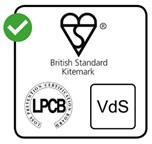 Boats present a challenging environment for alarms particularly with high humidity, temperature extremes, the potential for jolts and the regular vibration from some boat engines.
Boats present a challenging environment for alarms particularly with high humidity, temperature extremes, the potential for jolts and the regular vibration from some boat engines.
So to give you the most confidence in its reliability, choose an alarm meeting BS EN 14604:2005. Check for a British Standard ‘Kitemark’; a LPCB ‘Horseshoe’ mark or the square VdS symbol (see below) as these show that the claim of meeting a Standard has been independently certified.
The Fire Industry Association (FIA) has produced a list of smoke alarms by manufacturer and model that are suitable for boats.
Click here |
|
Are you looking for information on carbon monoxide (CO) alarms? Click here » |
The two types of detector on smoke alarms
There are two main types of detector (or sensor) on smoke alarms, - ionisation and optical (also known as photoelectric cell). The products are often named after them, i.e. optical sensor alarms or ionisation alarms.
Optical sensor alarms - or better still optical sensor alarms with thermal enhancement - and a hush button are the best choice for boats. They are more effective at detecting slow-burning fires (such as smouldering wood, burning foam-filled furniture, overheated wiring etc).
The hush button can be used to temporarily silence the alarm typically while frying or grilling food at the cooker or making toast.
Optical alarms are less likely to go off accidentally, and so are best for confined environments, a feature of most boats. Although they are more expensive currently, online shopping may offer a wider choice and price range.
Ionisation alarms are more readily available in high street shops. They use a radio-active isotope and are very sensitive to flaming fires, (ones that burn fiercely such as chip-pan fires) and they will detect this type of fire before the smoke gets too thick.
If you think your boat is at risk from both slow-burning and flaming fires you should consider installing one of each, indeed there are some units available with the two types of sensor in the same housing.
However, if you can’t have both it’s still safer to have one smoke alarm than none at all and in summary that would be an optical alarm with a long-life battery, a hush button and one that meets BS EN 14604:2005, preferably also carrying one of the certification marks shown below.
More on the various alarm types and features >>
|
Look for these symbols before buying your alarm |

